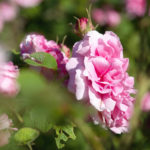Roses and extracts
Our Roses and their Properties
The union of the four roses produces a unique and exclusive result.
Damask Rose
This rose was probably brought to the West by the Crusaders from faraway Syria and immediately became sought after in European courts for its fragrance and extraordinary pharmacological properties.
The Damask Rose forms the basis of all our cosmetics. It has been known for thousands of years for its beneficial properties and used in many cultures for natural medicinal cures.
Rich in anti-ageing active ingredients such as bioflavonoids and anthocyanins, it also has excellent moisturising and soothing properties.
The Valle Scrivia Rose
A rare rose that had almost become extinct and was recovered a few years ago with the support of the University of Genoa.
For centuries it has been cultivated in the Scrivia Valley for use in the production of food preserves such as syrup and petal jelly, which are known for their persistent fragrance and natural deep red colour.
It contains a substance that is particularly active against germs and bacteria and helps restore the correct pH of the skin, soothing redness and irritation.
OUR ROSE EXTRACTS: NATURAL, PRECIOUS, EFFECTIVE
Natural
To produce our rose extracts we only use the petals of the flowers grown on our JB Rose Farm and the seeds of the wild roses that grow in the forests and glades of our valley.
Our distinguishing feature is the particularly pure rose petal extract with a high concentration of active ingredients.
Precious
Damask Rose essential oil is among the most valuable ingredients in natural cosmetics and is highly valued for its numerous active substances, some 140 in number, and its anti-ageing, antiseptic and soothing properties.
More than 300 kg of roses are needed to obtain 1 g of essential oil.
The quantity of extract from our roses guarantees the production of only a few thousand pieces. For this reason, our products are only distributed in a few selected outlets.
Effective
The ultrasound extraction technique (also known as ‘cold extraction’, and used by major cosmetic brands) does not damage thermolabile substances. It produces a very rich extract in which numerous active substances are available that are not present in traditional extracts, which, moreover, often contain traces of the chemical solvents used in the process.




